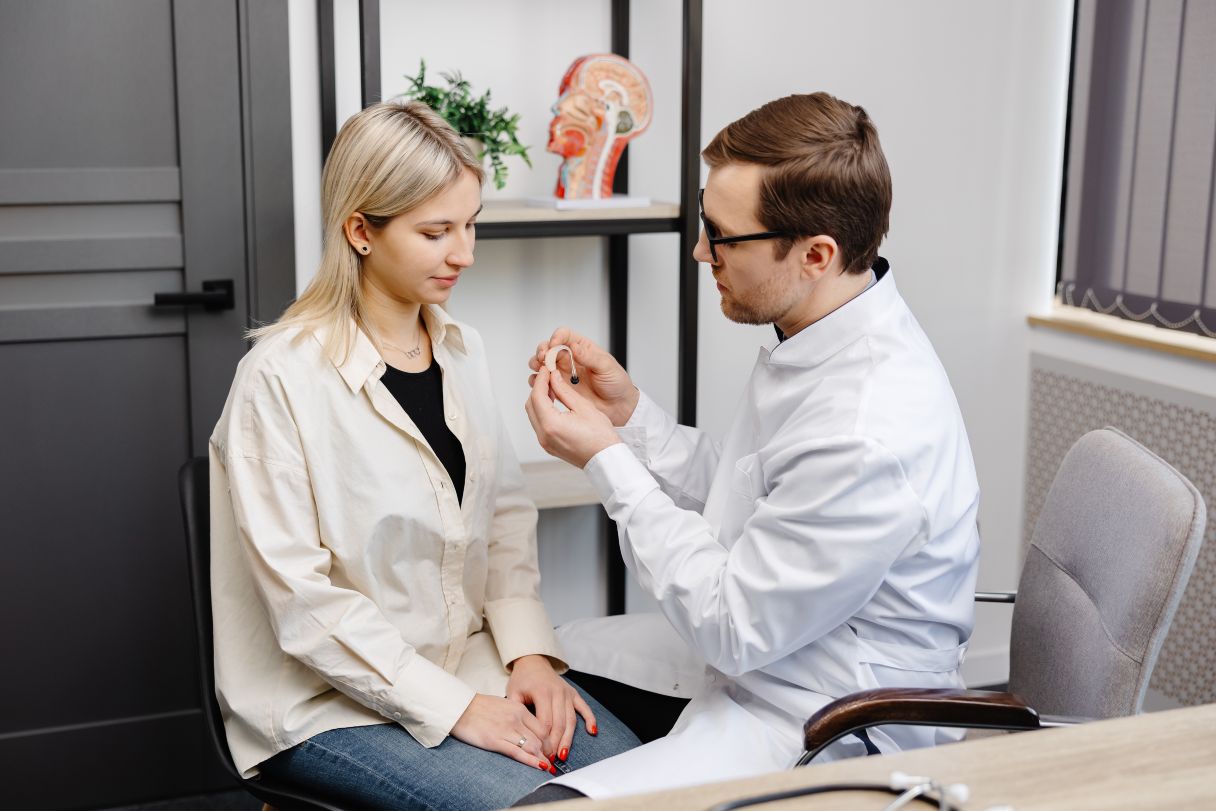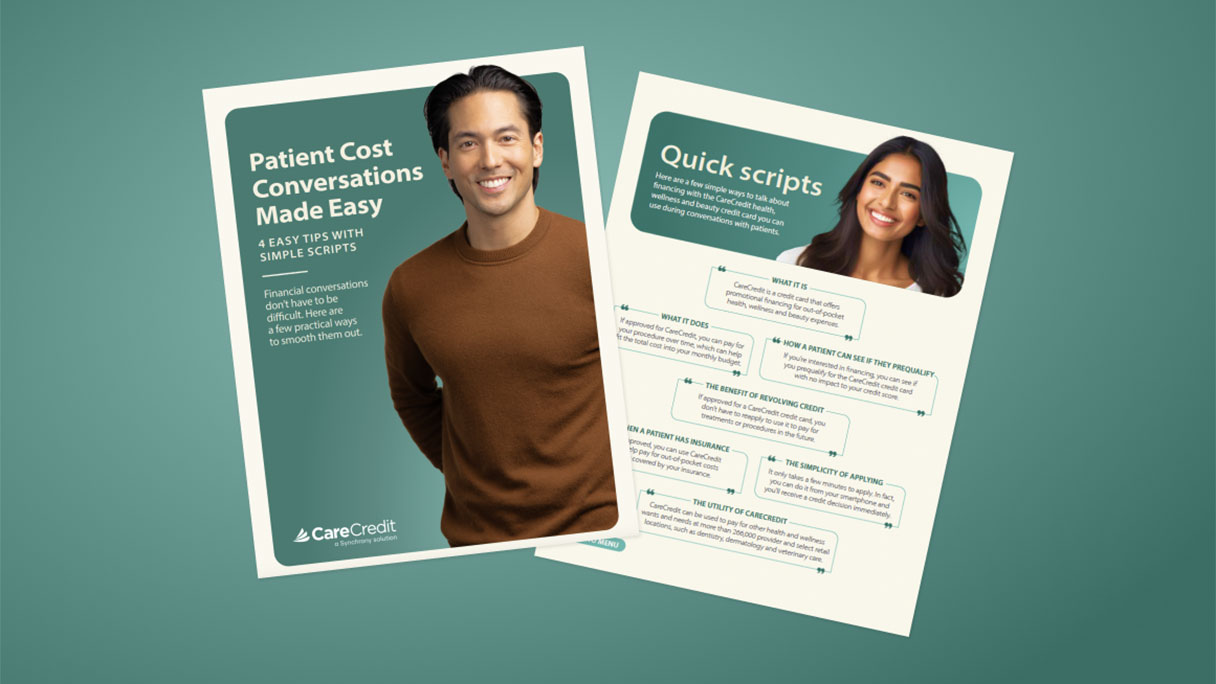How to Promote Hearing Device Acceptance at Your Audiology Practice
Hearing devices can boost the quality of life for patients with hearing loss — but only if they wear them. Here’s why patients may be reluctant to adopt these devices and how your audiology practice can help.
By Robyn Tellefsen
Digital Writer
Posted Jun 20, 2025 - 8 min read

Did you know that 86% of people with hearing devices wish they had gotten them sooner according to Synchrony's Hearing Health and Loss Prevention Study?1
That’s where you come in. Audiologists can play an essential role in raising hearing loss awareness and facilitating acceptance of hearing care recommendations, including hearing devices. There are many reasons why patients reject or put off getting these devices — from embarrassment to cost — and it's important for audiologists to know these reasons and how to respond. And since hearing devices may not be fully covered or reimbursed by insurance, offering financing options can help your patients move forward with care and find devices that fit their budget.
Learn more about the impact of untreated hearing loss, common barriers to hearing device acceptance, strategies to enhance acceptance and how financing can help.
The Impact of Untreated Hearing Loss
By 2050, hearing loss is expected to affect nearly 2.5 billion people worldwide — a 56% increase from 2019.2 And as you know, it’s not just older adults who are having trouble hearing: 40% of young adults under 30 have some level of hearing loss, according to Synchrony's study.1
Hearing is essential to the way we experience the world, so untreated hearing loss can have a profound impact on the quality of life and well-being of your patients.3 About 18% of adults (ages 20-69) who have moderate or severe hearing loss also have depression.4
However, research suggests that treatment such as hearing aids may help preserve cognitive function, protect against depression and improve quality of life.5 Yet less than 30% of older adults (ages 70 and above) with hearing loss — and only 16% of young and middle-aged adults (ages 20 to 69) — who could benefit from hearing aids have ever used them.4
5 Common Barriers to Hearing Device Acceptance
Here are five reasons why patients may be reluctant to use hearing devices:2
- Lack of awareness of their condition. Patients may not be fully aware of their hearing loss or its impact on their life. Because of this, they may delay seeking treatment and accepting the use of hearing devices.
- Social stigma. According to Synchrony's study, only 23% of people say they would wear a hearing device if it’s necessary. And 6 in 10 people who wear hearing devices are embarrassed to be seen wearing them and would prefer not to wear them.1
- Discomfort. Patients may find hearing devices uncomfortable to wear or difficult to use. This is one of the most common barriers to hearing device acceptance.
- Lack of perceived benefits. People who don’t think hearing devices significantly improve their hearing or ability to communicate are more likely to reject them. This is another one of the most common reasons why patients don’t use hearing devices.
- Cost. Patients may not have the financial resources to pay for hearing devices or care.2 The Synchrony study reveals that 34% of patients who have hearing loss but don’t have a hearing device cite expense as a reason they won’t consider getting one — even if their hearing gets worse.1
Average cost of hearing devices
Consider the average cost* of various hearing devices:6
| Hearing device | Average cost |
| Analog hearing aid (pair) | $1,354 |
| Digital hearing aid (pair) | $2,114 |
| Bone-anchored hearing system (transcutaneous) | $13,854 |
| Middle ear implants | $16,318 |
| Cochlear implants | $51,072 |
| Auditory brainstem implants | $55,869 |
With rising costs, patients may struggle to manage audiology care expenses — but 35% of patients with hearing loss said a lower cost would increase the likelihood they would consider wearing a hearing device, according to Synchrony's study.1 By offering financing options like the CareCredit credit card, your practice could help patients fit the cost of hearing care into their monthly budget.
8 Strategies to Enhance Hearing Device Acceptance
Hearing healthcare professionals play a pivotal role in educating and supporting patients throughout the care journey, including the process of adopting and using hearing devices. By making patients aware of their hearing loss and its impact on their daily life, you can help them accept hearing devices more readily.2
Consider these eight strategies to promote hearing device acceptance:
1. Discuss the effects of untreated hearing loss
According to the Synchrony study, few consumers are aware of the connection between untreated hearing loss and their health later in life — and knowing about the link influences their decision to get their hearing checked. By providing information on the potential impacts of untreated hearing loss, you could help motivate your patients to accept care.1
2. Address the social stigma
Young adults may feel like an anomaly because of their hearing loss. Meanwhile, older adults may fear a negative perception of aging or disability.7 To help address this stigma, you can show them how modern hearing devices are much more attractive and less obtrusive than devices of the past.7
Read Related Articles
7 Tips for Engaging Younger Patients in Their Hearing Health
Myths About Hearing Loss and How Audiologists Can Debunk Them
3. Educate patients on the use and care of hearing devices
When patients can confidently manage their hearing devices, they may experience higher success and satisfaction with their use.3 In addition, patients who use hearing devices for more hours per day may achieve greater satisfaction with them.2 So be sure to provide detailed instructions to patients and families on topics such as:8
- Battery management
- Connectivity to smart devices and other assistive technologies
- Device components and features
- Feedback management
- Insertion and removal of devices
- Routine maintenance, cleaning and storage
- Wearing schedule
4. Emphasize tech features
For patients who are more technologically inclined, you can use tech features and technologies such as Bluetooth® to help them accept and use the device.8 Patients may be especially interested in the multifunctionality of modern hearing aids, including features like fall detection, fitness tracking and even language translation.7
5. Provide holistic support
Rather than focusing solely on the audiological aspects of care, keep the needs and goals of the patient and their family top of mind.3 Listen closely to discover what kinds of communication environments are important to the patient.2 Family members and other communication partners can also be key to decision-making.3 And the more social support a patient has, the greater the likelihood that they will accept their hearing device.2
6. Highlight the importance of follow-up care
Regular monitoring may increase the likelihood that patients will keep using their hearing devices. Ensure that patients know your practice is there to provide ongoing support through follow-up appointments, and encourage them to return for adjustments and calibration as their hearing needs evolve.2
7. Foster realistic expectations
Patients who understand the way hearing devices work — including what they can and can’t do — are more likely to keep using them.2 Be sure to inform patients and their families of possible hearing device limitations, such as these:8
- There is usually an adjustment period.
- The benefits of hearing devices may vary across settings (e.g., quiet vs. noisy spaces).
- Hearing aids are mainly designed to amplify speech, so patients may experience challenges listening to music.
- Communication challenges may not be resolved entirely with hearing devices alone; some patients may benefit from auditory training.
8. Offer more payment options
According to the Synchrony study, 58% of people who have hearing loss but don’t use a hearing device like the idea of being able to finance the cost of one. Flexible financing could help patients consider wearing a hearing device — and could even help them purchase a better one.1
How Financing Can Help With Hearing Device Acceptance
Financing can help patients manage the cost of recommended audiology care, including hearing devices. By providing patients with financing options, you can help them prioritize their hearing health and make it easier to get hearing devices.1
For example, the CareCredit credit card can help make out-of-pocket costs more manageable with flexible financing options, helping patients commit to the hearing healthcare they want and need.** Patients can split the costs of care into manageable payments, and providers can receive payment within two days of the transaction — which can help reduce time spent on accounts receivable.
Cost and payment plan example
The average cost* of digital hearing aids is $2,114.6 Let's see how a 12-month promotional financing offer with CareCredit could work.
Consider this scenario: Ms. Miller owes $2,114 for digital hearing aids, which are not covered by her insurance plan. With a financing solution like CareCredit, she can break up that cost into 12 payments, which amounts to suggested equal monthly payments of $177 per month.
As long as Ms. Miller makes her required minimum monthly payments and pays the entire promotional balance within the 12-month promotional period, she can pay for her digital hearing aids over time and avoid paying interest. If she doesn’t pay the $2,114 in full within the 12-month promotional period, interest will be charged to her account from the purchase date.
Learn More: Explore how CareCredit works for providers so you can start leveraging this patient financing solution within your audiology practice.
Discussing financing with patients
If you need help discussing financing with your hearing care patients, try adapting this sample script:
“Ms. Miller, as you may know, health insurance may not cover hearing aids very well. I understand that can be frustrating, but I also understand the positive impact that good hearing can have on your life and on the lives of your loved ones.
“That’s why our practice offers the CareCredit credit card. If approved, it offers promotional financing and can be used again and again for future out-of-pocket healthcare costs in the CareCredit network. Would you like to see what your monthly payment may be with CareCredit?”
If the patient is not yet ready to commit to care, you can use this script to continue the conversation:
“Ms. Miller, I understand you want time to talk this over with your family. I’ve put together this information package that details your hearing loss, the recommended technology, cost and a financing option. May I give you a call on Wednesday so I can answer any questions you may have? Is morning or afternoon better for you?”
Learn More: Get tips for having effective financial conversations with your patients.
Prioritizing Hearing Healthcare
While the impact of untreated hearing loss can be significant, devices like hearing aids can vastly improve patients’ lives.2 By taking steps like providing comprehensive patient education, addressing hearing aid stigma and offering patient financing, your audiology practice can help reduce barriers to care, motivate patients to prioritize their hearing health and promote hearing device acceptance.
A Patient Financing Solution for Your Hearing Care Practice
If you want to help your patients manage the cost of your practice's exams, procedures and products, consider offering CareCredit as a financing solution. CareCredit allows cardholders to pay for things like hearing care services and devices over time while helping to enhance the payments process for your practice.
When you accept CareCredit, patients can see if they prequalify with no impact to their credit score, and those who apply, if approved, can take advantage of special financing on qualifying purchases.** Additionally, you will be paid directly within two business days.
Learn more about the CareCredit credit card as a patient financing solution for your hearing care practice or start the provider enrollment process by filling out this form.
Author Bio
Robyn Tellefsen is a freelance writer and editor with more than 20 years of experience covering health and wellness, finance and more. Her work has appeared on sites such as LoopNet, Beachside Rehab, First Horizon Bank, SoFi, A Place for Mom, American Express, Chase and more.
Healthcare payment and financing solution
The CareCredit health and wellness credit card helps improve the payment experience for patients and clients, and your financial performance.
Get StartedReady to help more patients and clients get the care they want and need?
Get StartedReady to help more patients and clients get the care they want and need?
Get Started*Actual cost may vary based on geography, provider and other variables. Cost information is based on research in the 50 United States and the District of Columbia, which was conducted by ASQ360° in 2024 on behalf of Synchrony’s CareCredit.
**Subject to credit approval.
The information, opinions and recommendations expressed in the article are for informational purposes only. Information has been obtained from sources generally believed to be reliable. However, because of the possibility of human or mechanical error by our sources, or any other, Synchrony and any of its affiliates, including CareCredit, (collectively, “Synchrony”) does not provide any warranty as to the accuracy, adequacy, or completeness of any information for its intended purpose or any results obtained from the use of such information. The data presented in the article was current as of the time of writing. Please consult with your individual advisors with respect to any information presented.
All product, service, and company names are the trademarks of their original owners. The use of any trade name or trademark is for identification and reference only and does not imply any endorsement, sponsorship, or affiliation by or with the trademark holder of their brand.
© 2025 Synchrony Bank.
Sources:
1 Hearing Health and Loss Prevention Study, Synchrony. February 2024. (CareCredit is a Synchrony solution.)
2 Marcos-Alonso, Susana et al. “Factors impacting the use or rejection of hearing aids — A systematic review and meta-analysis,” Journal of Clinical Medicine. June 13, 2023. Retrieved from: https://pmc.ncbi.nlm.nih.gov/articles/PMC10299666/
3 Franks, Inga and Timmer, Barbra H. B. “Reasons for the non-use of hearing aids: Perspectives of non-users, past users and family members,” International Journal of Audiology. October 23, 2023. Retrieved from: https://www.tandfonline.com/doi/full/10.1080/14992027.2023.2270703
4 “Quick statistics about hearing, balance and dizziness,” National Institute on Deafness and Other Communication Disorders. Updated September 20, 2024. Retrieved from: https://www.nidcd.nih.gov/health/statistics/quick-statistics-hearing
5 “Hearing loss and tinnitus statistics,” Hearing Health Foundation. Accessed June 4, 2025. Retrieved from: https://hearinghealthfoundation.org/hearing-loss-tinnitus-statistics
6 2024 Synchrony Average Procedural Cost Study for Cosmetic, Dental, Veterinary, Vision and Other Practices Across the United States, conducted by ASQ360° Market Research, Cost Tables.
7 Madara, Edward and Bhowmik, Achintya K. “Toward alleviating the stigma of hearing aids: A review,” Audiology Research. December 4, 2024. Retrieved from: https://pmc.ncbi.nlm.nih.gov/articles/PMC11673210/
8 “Hearing aids for adults,” American Speech-Language-Hearing Association. Accessed June 4, 2025. Retrieved from: www.asha.org/Practice-Portal/Professional-Issues/Hearing-Aids-For-Adults/




